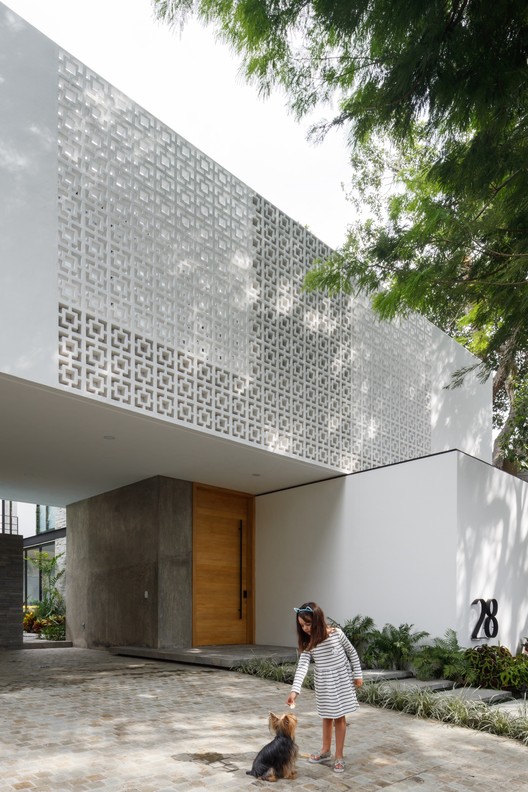Shepherd of the Valley Chapel 3six0 Architecture
2011-08-11 00:00
位于罗德岛霍普的联合卫理公会山谷牧羊人,雇佣了3600建筑来准备一份研究报告,以满足他们扩展的需要。现有的教堂,建于1970年,使用预制的乙烯基边木建筑,已经发展得太大,不再足以满足礼拜、教育和其他活动的需要。36.0的研究显示,迫切需要一个新的教育翼,重建圣所,重新组织入口,以及对现有建筑的外部进行全面翻新。在扩建的第一阶段,3600被指示在现有的机构中设计一个附加的礼拜堂。
Shepherd of the Valley, a United Methodist Church in Hope, Rhode Island, hired 3six0 Architecture to prepare a study for their needs to expand. The existing church, built in 1970 using pre-fabricated vinyl-sided wooded construction, had grown too large and was no longer adequate for meeting the needs of worship, ministry, education, and other activities. 3six0's study revealed pressing needs for a new eduction wing, restructured sanctuary, reorganized entry, and an overall renovation of the existing building's exterior. For the first phase of expansion, 3six0 was instructed to design an appended chapel to the existing establishment.
© John Horner Photography
礼拜堂的设计是从计划和围墙开始的。礼拜堂南端的墙壁开始是教育侧现存围墙的延续。然而,西墙的角度向内,以保持一个开放的户外空间,可供收集。由于东墙和西墙不是平行的,而且由于脊梁两侧的天花板几何形状分别与东墙和西墙分别是正方形的,因此几何线继续从墙到顶、从墙到楼、像一根包裹空间的绳子一样盘旋。随着几何学向北移动,螺旋线逐渐收缩,接近几何无限大的极限。“螺旋”来源于拉丁文中的“精神”(Spirare)-一个像呼吸和相关词一样不断膨胀和收缩的人物,呼吸,激励,到期,以及教堂的“尖顶”。
The design of the chapel started with the plan and its perimeter walls. The walls at the south end of the chapel start as a continuation of the existing walls of the education wing. The west wall however, angles inward, in order to maintain an open outdoor space that could serve for gathering. Because the east and west walls are not parallel and because the ceiling's geometry on each side of the ridge beam is square to the east and west walls respectively, the lines of the geometry continue to spiral around from wall to ceiling, to wall to floor, like a string wrapping the space. The lines of the spiral slowly contract as the geometry moves northward approaching the geometrical infinite limit. "Spiral" comes from the Latin word, "spirare" or spirit - a figure that is always expanding and contracting like breath and the related words, respire, inspire, expire, and for the chapel, "spire."
© John Horner Photography
教堂的螺旋几何级数是在教堂的窗户开口处的外部提出的,因为窗户的宽度随着接近建筑物的北端而变窄。礼拜堂用舌皮紧绷,沟槽垂直纹,西红雪松,东面和西面的墙壁向外倾斜,让雨水自由流过大楼。窗户的门框由斜墙表面支撑着一根真正的铅垂线的索菲勒莫哈尼肋骨支撑着。建筑物的关键连接处与镀锌铜相连,铜层向上延伸,形成雨水分流器、护墙帽闪烁、喷口和倾斜墙与铅墙之间的过渡段。
The spiraling geometric order of the chapel is suggested on the exterior of the chapel at the window openings in that the widths of the windows become narrower as they approach the north end of the building. The chapel is clad in a taut skin of tongue and groove vertical grain western red cedar with the east and west walls canting outward, allowing rain water to fall freely past the building. The jambs of the windows are bracketed by sapele mohagany ribs that hold a true plumb line against the canting wall surface. Critical junctures of the building are articulated with zinc coated copper that extend upward to create rain water diverters, parapet cap flashing, downspouts and transition pieces between canted and plumb walls.
© John Horner Photography
天花板的南边是一个9英尺高的平面,并随着螺旋向北收缩到18英尺的高度逐渐向上推进。几何学永远不会关闭,但接近一个无限的极限,在教堂的北端,屋顶留下一个缺口,在天窗,照亮北墙。
The south edge of the ceiling is a flat level at nine feet high, and progressively pushed upward as the spiral contracts towards the north reaching a height of eighteen feet. The geometry never closes, but approaches an infinite limit at the north end of the chapel where the roof leaves a gap at a skylight that illuminates the north wall.
© John Horner Photography
入口处的几何空间顺序偏离了现有的教育翼,在新旧建筑之间形成了一个铰链式的空隙。凹槽,板岩地板和墙壁的图案,遵循几何级数的线条。在某些时候,墙壁没有达到天花板和地板。门厅双倍回到自己,导致进入小礼拜堂的空间。
The entry is at the point where the geometric spatial order pulls away from the existing education wing and forms a hinged gap between the new and the old buildings. The recessed light troughs, the pattern of the slate flooring and the walls, follow the lines of the geometric order. At some points the walls are short of reaching the ceiling and the floor. The foyer doubles back on itself leading to the entry of the chapel space.
© John Horner Photography
 举报
举报
别默默的看了,快登录帮我评论一下吧!:)
注册
登录
更多评论
相关文章
-

描边风设计中,最容易犯的8种问题分析
2018年走过了四分之一,LOGO设计趋势也清晰了LOGO设计
-

描边风设计中,最容易犯的8种问题分析
2018年走过了四分之一,LOGO设计趋势也清晰了LOGO设计
-

描边风设计中,最容易犯的8种问题分析
2018年走过了四分之一,LOGO设计趋势也清晰了LOGO设计






























































